Collection: JR East E231, E233 and 531
Electric Multiple-Unit Commuter and Suburban Trains
JR East is responsible for passenger trains in the northern part of Japan’s main island, including the Kato region around Tōkyō. This makes it one of the larger operators of trains in the nation, and provides it with both a need and an income to fund development of new designs. The E231 was the culmination of a redesign process begun more than a decade earlier under the original Japan National Railway to design a more cost-effective urban/suburban commuter train. The E233 was an updated version of this with a similar, though visibly different, appearance, and the E531 as a dual-voltage version of the E231 for outer suburban use on the Jōban line. JR East operates variants of this design customized for specific needs on a number of railway lines in and around Tōkyō.
New variants of the E233 continue to be produced, with versions planned for introduction to the Saikyō Line in 2013 and the Yokohama Line in 2014.
Commuter Trains in the Tōkyō area operate on both individual lines and as run-through services originating on one line and traveling through others. Not all of these operate into Tōkyō Station itself, as many terminate at other stations where passengers can transfer to lines going to Tōkyō Station and other destinations within the city. Trains may also start off as one long train in the city, and split into two trains further out, diverging onto two different routes. These trains will have two sets of cab cars.
Commuter services are broadly divided into Local and Rapid services. The former making all stops, and the latter having limited stops. Many trains are local in outlying areas, and make limited stops as they approach the city center where they share track with other trains. Some trains also operate as Rapid services at peak times, and Local at other times.
Suburban trains are a variation of commuter trains, often using similar equipment, but serving more remote destinations and modified for that use with more seating and toilet facilities that are absent from trains used only in more central locations.
This page is arranged by model number (e.g., E231 comes before E233, and E231-800 before E231-1000), except for the Yamanote Line E231-500 which comes first, as it was my first Japanese train model and holds pride of place in my collection.
Yamanote Line E231-500
The Yamanote Line is a circular route around the center of Tōkyō. The E231-500 series, operating in 11-car trains, have run on this line since 2000. Top speed of the equipment is 120 kph, although trains on this line average 35 kph, making a loop in as little as 59 minutes. Trains are marked with a green stripe, and run every 2 and a half minutes at peak times. The Yamanote line version differs in having more motorized cars (six per train instead of four) on the prototype, and in the use of a pair of six-door cars for rapid loading/unloading at peak times. Six door cars were used on some other lines, but aren’t typical, and on the Yamanote line they were phased out in 2010 when platform gates were introduced.
The line operates entirely above ground, in cuts, fills and on elevated viaduct in places, using dedicated tracks not shared with any other trains. Over the entire route, there is only a single grade crossing. A portion of the line on the west side of the city runs parallel to the Yamanote Freight Line, a former double-track freight line now used largely, though not completely, for passenger trains. Other portions of the line parallel the Jōban and Keihin-Tōhoku lines on the north-east side of the city, and the Tokaido line on the south-east.
Kato has released models of this train at least four times, in 2005 (possibly a re-release of an earlier model given the number), 2007, 2009 and 2012 (there are two 2012 editions, one with markings commemorating the Suica train-pass cards that has images of a penguin on it; I don’t have that one). The first version (10-258/259) was probably not designed for DCC, the later ones all were and feature the flywheel-equipped skew-wound three-pole motors typical of Kato’s “DCC Friendly” models (meaning the cab and motor cars have sockets for Kato’s decoders).
So far, I have two of these. I’m likely to acquire more, as this is the train that sparked my interest in modeling modern Japanese trains, and the model is an excellent one.
My first is the 2007 set (sold as two sets: 10-261/262), which consists of the 5-car base set, and a 6-car expansion set, for a complete 11-car train, including the two six-door cars originally used on these trains. This version has working head and tail lights, and is “DCC friendly” (i.e., it is equipped with sockets for DCC decoders in the motor car and two end cars), and the set is compatible with LED car lights (11-209/210). Without DCC the red/white lights are controlled by the directional setting of the power pack (i.e., by the polarity of the DC power).
My second is the version released in 2009 (10-578, 4-car base set with motor, 10-579, 4-car add-on, and 10-580, 3 car add-on).
In 2011 Kato released the 10-577 set of two four-door cars, which could be used to modernize any of the earlier trains to reflect a period when the six-door cars were no longer in use.
Following these, a new set was released in 2012 (10-890/891/892) which replaced the six-door cars with four-door cars, to model the newer versions of these trains. I don’t have one of these, yet, but likely will get one sooner or later. This set reports compatibility with the new “version 2” interior LED lights. Finally, in late 2012 Kato announced a model commemorating the tenth anniversary of the Suica fare card. This model has decals applied matching the advertising banners used on the prototype commemorative “Penguin Train” (the Suica logo is a saluting penguin). At present, this appears to only be available as a four-car set (no Kato set number).
Kato isn’t the only company making models of this train; it’s very popular. Both Tomix and Micro Ace have also produced models of it, although I don’t have any of those.
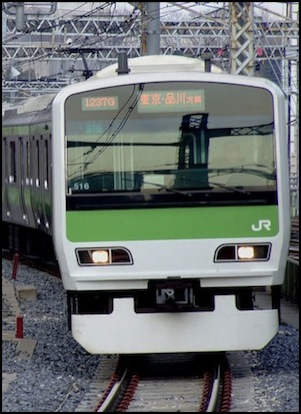
Photographer: LERK
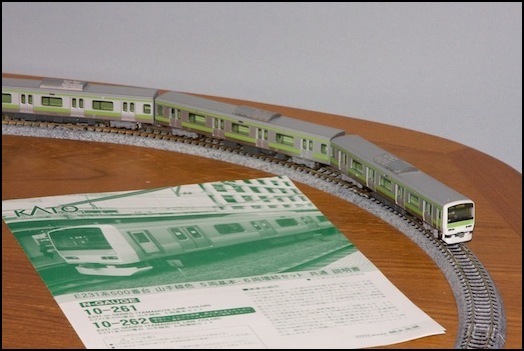
Kato E231-500 Yamanote Line (original version)
Kato 10-261, 10-262 (11 cars, 1 motorized)
DCC Status: not yet converted
Interior Lighting: compatible, not yet installed
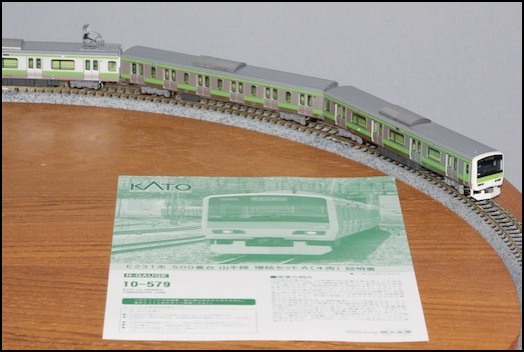
Kato E231-500 Yamanote Line (2009 version model)
Kato 10-578, 10-579, 10-580 (11 cars, 1 motorized)
DCC Status: not yet converted
Interior Lighting: compatible, not yet installed
Jōban Line E231-0
The E231-0 is also in use on the Jōban Line, in 10+5 sets. The Jōban Line is one of Tōkyō’s larger lines, running 343 km from Nippori station on the north side of Tokyo to the Northern city of Iwanuma (per wikipedia, most trains operate to Ueno just north of the city center over the parallel Tōhoku Main Line; possibly some also extend to Sendai over an outer section of that same line). And from just outside the city to Toride, the line is quadruple tracked (likely to support local commuters in addition to distant Rapid and inter-city services). However, beyond Toride (37 km from Nippori) the line is electrified with AC power, so outer-suburban trains must be dual-voltage models (such as the E531), the single-voltage E231 (and E233) can only operate on the inner section.
Kato released a model of this in 2008, sets 10-551, 10-552 and 10-553. This produces a 10+5 car train with two sets of cab cars. Both sets are motorized and can be run independently or coupled together and run as a single train. I have one of this train (all three sets).
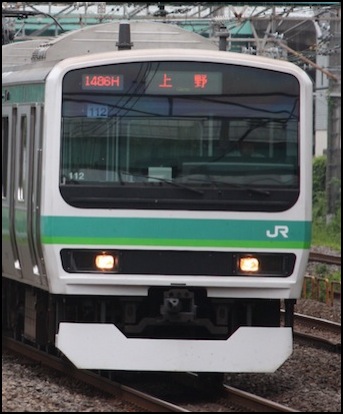
Photographer: TC411-507
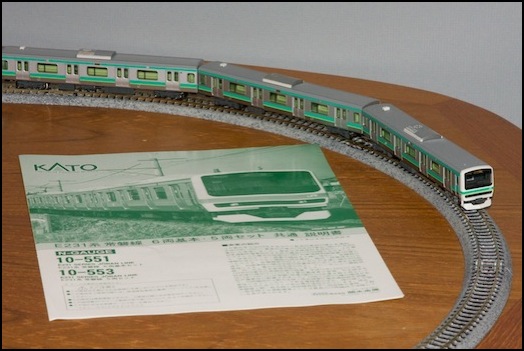
Kato E231-0 Jōban Line
Kato 10-551, 10-552 and 10-553 (10+5 cars, 2 motorized)
DCC Status: Connverted with EM13 and two Cab Car FL12 decoders
Interior Lighting: compatible, not yet installed
Sobu Line E231-0
JR East also uses the E231-0 variant on the Chūō-Sōbu line. These trains are marked with a yellow Sōbu line stripe to differentiate them from trains operating only on the Chūō line, which have an orange stripe. The Sōbu Line operates east of the city 39 km from Chiba station in the prefecture of the same name, with trains running into Tōkyō station (via an underground extension) or continuing through Akihabara station onto the Chūō-Sōbu line, which operates west parallel to the Chūō Main Line.
Kato has never made a model of these for some reason. Thankfully, Micro Ace did, and I have two of them (one has a bad motor however, which probably needs to be cleaned and lubricated; my own fault for leaving it running unsupervised where it got stuck against a box with the motor stalled and overheating).
The Micro Ace model released in 2010 is two sets (A4012 and A4013) that form a ten-car train depicting a later “strengthened skirt” design variation (the “skirt” is the white panel below the cab that keeps objects from getting caught in the wheels). This model also has a six-door car (only one, which is typical of this train).
Micro Ace had earlier (2003) done a model of the E231-900 (the prototype E231) in Sōbu colors, sets A4030 and A4031, but I don’t have that one. It’s long sold out, so unless they re-release it, I likely never will.
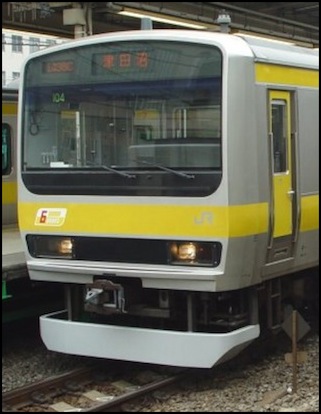
Photographer: DAJF
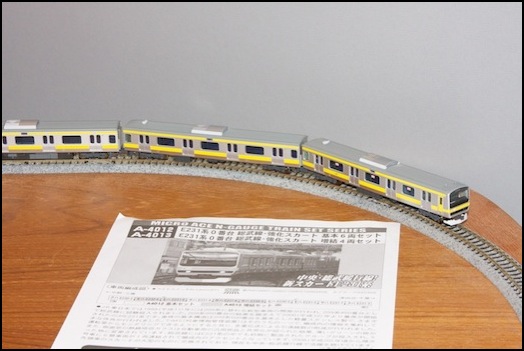
Micro Ace E231-0 Sōbu Line (or Chūō-Sōbu Line)
Micro Ace A4012, A4013 (10 cars, 1 motorized)
DCC Status: not yet converted
Interior Lighting: compatible with MA lighting, not yet installed
Chūō-Sōbu / Tozai Line E231-800
The E231-800 is a particularly interesting variant, and one of which I’d long wanted a model. In 2011 Micro Ace finally released one (MicroAce A8460, A8461). What makes this train special is that although it is mechanically an E231, the appearance is somewhat different because it is one of the commuter trains that runs through onto a subway line, and so the cars have a slightly smaller profile, and the cab ends are equipped with emergency exits in case the train breaks down in a tunnel where the side doors can’t be used. The car is decorated with the two-tone blue strip of the Tōkyō Metro Tōzai line.
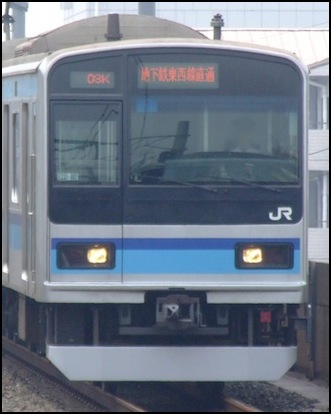
Photographer: LERK
(another train missing a roster photo; fix)
MicroAce A8460/A8461 (10 cars, 1 motorized)
DCC Status: not yet converted
Interior Lighting: TBD
Suburban Commuter E231-1000
There are a number of different outer-suburban trains sharing a common color-scheme and sometimes described simply as “suburban” trains rather than being identified with a specific line. Kato has done a number of models of these (as have Tomix and Micro Ace) although most of the Kato models represent a specific variant used on a specific line. On the prototype, these were formed in 10-car and 5-car sets, with a 10+5 arrangement often used in and near the city. On the 10-car sets, two double-decker cars were used.
Kato’s first model i(sets 10-231, 10-232 and 10-233) and represents a Tōkaidō Line version. The 10-231 and 10-232 sets model a 10-car train, and the 10-233 adds a 5-car train. It’s unclear if the 5-car train was separately motorized, although prices I’ve seen imply it was (and this was more common of Kato’s older short sets). I don’t have one of these models. It appears to have been re-released in 2005, but the model likely predates the 2003 model with a higher series number.
The (likely) second model (sets 10-471, 10-472 and 10-473) was released in 2003. This appears to be an update of the earlier model replacing the double-decker cars with single-deck cars. However, Kato describes it simply as a “suburban” train and doesn’t specify a given line. In this set both the 10-car and 5-car trains had motors. This train supported the standardized interior lighting (in the 11-204/11-206 bulb version, although LED sets should work with it too). Note that use of the lighting sets in the double-deck cars isn’t possible. I have the 10-471 (eight-car subset of a train) but not the other two cars or the 5-car set. This train predates DCC.
The third set, dating from 2007 also had a 10+5 arrangement, with the first two sets (10-520 and 10-521) forming a 10-car train with two bi-level cars, and a separate motorized 5-car train (10-522). Both were described as a Tōkaidō Line / Shōnan-Shinjuku Line version. I don’t have this train. This train was probably designed for Kato’s DCC decoders.
Kato did something a bit odd with the fourth version (sets 10-594, 10-595 and 10-596) dating from 2009 or 2010. Although there were still three packages, there were fewer cars in each, and all three were needed to model one ten-car train with single-deck cars. Separately the 10-522 5-car set was apparently re-released to go along with it. Both were again described as a Tōkaidō Line / Shōnan-Shinjuku Line version. I have the ten-car train, but not the separate five-car train. This train is designed for Kato’s DCC decoders.
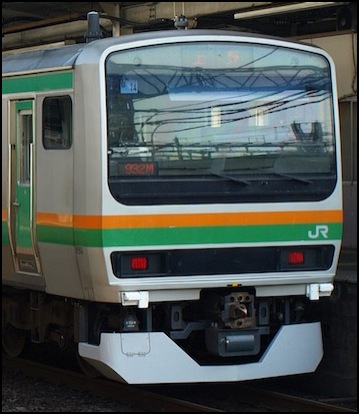
Photographer: 七号 (Nana-gō)
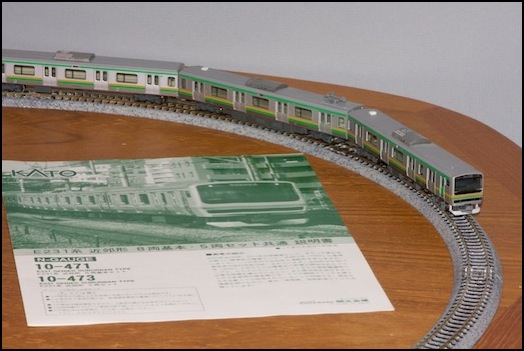
Kato 10-471 Suburban Commuter
Kato 10-471 (8 cars from the 10-car set, 1 motorized)
DCC Status: older
Interior Lighting: compatible (except double-deck cars), not yet installed
(no roster photo of 10-5xx train; need to fix that)
Kato 10-594, 10-595 (10-car set, 1 motorized)
DCC Status: compatible, not yet installed
Interior Lighting: compatible (except double-deck cars), not yet installed
Chūō Line E233-0
The Chūō Main Line runs from Tōkyō to Nagoya, over 397 kilometers to the west. Chūō means central, which is both a reference to the ward of the city where it ends, and to the line’s geographic location along the center of Japan’s main island. In the vicinity of Tōkyō it is divided into the Chūō Line (Rapid), which runs into Tōkyō Station, and the Chūō-Sōbu line, which crosses east-to-west just north of that station. The E233, which entered service in 2006, is used in Rapid service and marked with the orange stripe characteristic of that line. These trains do not operate into the Sōbu line east of the city center. The equipment has a top speed of 120 kph, and features redundant systems to prevent stoppages due to equipment failure.
Kato has released models of this train twice, in 2008 (10-541, 10-542) and 2009 (10-801, 10-802, 10-803). This train is structured as if it were a separable pair of six-car and four-car trains, with two sets of cab cars, however only one set is motorized. Oddly, the instruction sheet mentions DCC only for the lights, and does not mention the EM13 motor decoder. This may merely be a typo, but warrants further investigation.
The Kato model released in 2009 consists of a base model of a three-car train (including two cab cars and a motor car). Two expansion sets are available, 10-802 (set A) adds three cars to make a prototypical 6-car train, and 10-803 (set B) adds a four-car unpowered train (including two cab cars) to represent a coupled set. It comes with a destination sign for Takao, the end of the Rapid line 53 km from Tōkyō Station. The set is compatible with LED car lights (11-209/210). It is not listed as “DCC Friendly” on Kato’s website, but is (Kato tends to be very bad about advertising this feature, and even worse many of their newer trains use older tooling and still aren’t compatible with their DCC decoders so you can’t tell from the set number).
Tomix and Micro Ace have also released models of this train, although I don’t have either.
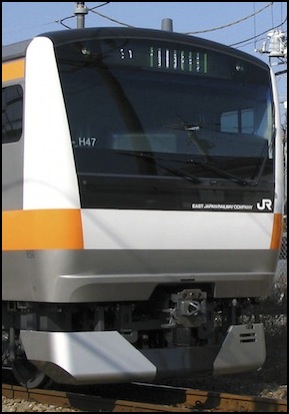
Photographer: Fg2
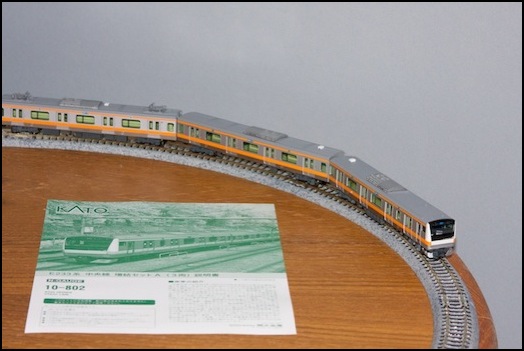
Kato E233-0 Ōme/Chūō Line
Kato 10-801, 10-802, 10-803 (10 cars, 1 motorized)
DCC Status: not yet converted, question about EM13
Interior Lighting: compatible, not yet installed
Keihin-Tōhoku Line E233-1000
The E233 is also used on the Keihin-Tōhoku Line, which runs north-south through Tōkyō Station using the Tōhoku and Tōkaidō lines.
Kato produced a model of this in 2008 (10-543, 10-544) which models a 10-car train. Oddly, the instructions mention DCC only for the interior lights, which suggests this is a pre-DCC car design. I have one of this train.
Tomix has also produced a model of this train.
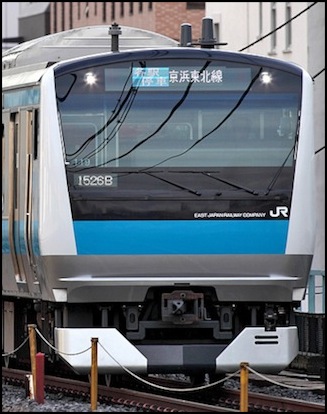
Photographer: Tennen-Gas
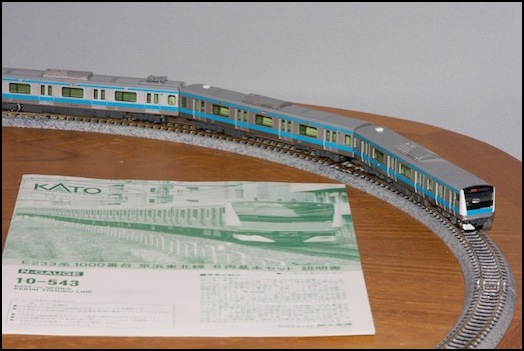
Kato E233-1000 Keihin-Tōhoku Line
Kato 10-543, 10-544 (10 cars, 1 motorized)
DCC Status: not yet converted, open questions
Interior Lighting: compatible, not yet installed
Jōban Line E233-2000
A variant of the E233 began operating on the Jōban line in 2009. As yet, nobody has produced a model of it.
Tōkaidō Line E233-3000
The E233 has been used on the Tōkaidō Main Line since 2008, replacing older 211 series stock.
Kato produced a model of this in 2010 (10-840, 10-841, 10-842). The first two sets provide a 10-car train with two double-decker cars, and the final set adds a 5-car train. From a description on a hobby store website, this more may be of a prototype design rather than the final design used in service, although it is unclear what differences may exist.
Kato produced an updated version of this train in 2012 (10-1114, 10-1115, 10-1116) with the same arrangement of cars. Both the 10-car and 5-car trains are separately motorized. This one is pre-marked as a specific set assigned to Tamachi Depot. This is the model I have. The instructions mention DCC only for lighting (cab and interior) and omit mention of the EM13 motor decoder.
Tomix has also produced a model of this train.
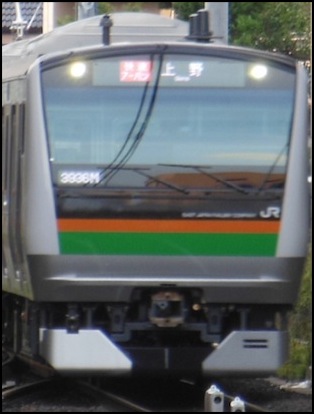
Protographer: Maru8
(no roster photo; fix)
Kato 10-1114, 10-1115, 10-1116 (15 cars, 2 motorized)
DCC Status: not yet converted, open question about EM13
Interior Lighting: compatible, not yet installed
Keiyō Line E233-5000
The E233 has been used on the Keiyō line since 2010, in both 10-car and 6+4 car sets (the latter with two sets of cab cars). These trains operate beyond the end of the Keiyō line, onto lines further out that feed it. At the Tōkyō Station end, the line runs underground to cross the Sumida river and enter the station.
Kato produced a model of the 6+4 version of this train in 2011 (10-862, 10-863). This train is designed for Kato’s DCC decoders. This is the one I have.
Tomix produced a model of the 10-car version in 2010.
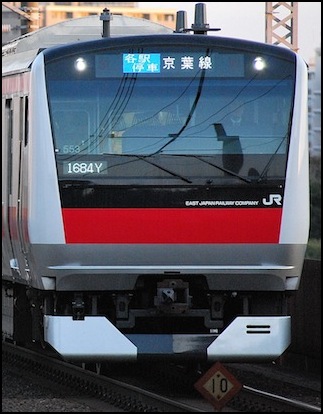
Photographer: Toshinori baba
(no roster photo; fix)
Kato 10-862, 10-863 (10 cars in 6+4 arrangement, 1 motorized)
DCC Status: not yet converted
Interior Lighting: compatible, not yet installed
Jōban Line E531
The E531 dual-voltage train was introduced to the Jōban Line in 2005. These operate in both 10 and 10+5 car arrangements near Tōkyō. In 2007 two single-level cars in the 10-car sets were replaced with bi-level cars. Interestingly, although the shape of the cab is typical E231, the headlight arrangement is that used on the E233 (up high). In addition to the usual 1,500 Volt DC these trains can also operate on 20 kV AC at 50Hz, as required for use on the outer part of the Jōban line.
Kato produced a model of these in 2006 (10-281, 10-282, 10-283) reflecting a 10+5 car train with single-level cars. From the price it’s likely that the 5-car train was also motorized.
A second version was produced in 2007 of the 10-car train with two bi-level cars (10-525, 10-526). No separate 5-car train was produced, and the 10-283 set was kept in production for this purpose.
A third version was produced in 2009 (10-570, 10-571, 10-572), again of the 10-car train with two bi-level coaches. This may have been the previous set simply rearranged into Kato’s new packaging that puts fewer cars in the introductory set. Again the 10-283 appears to have been retained for the 5-car train. I have this set (including the 10-283).
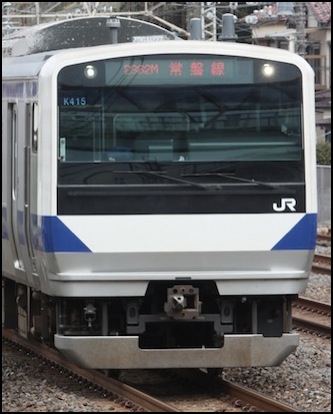
Photographer: TC411-507
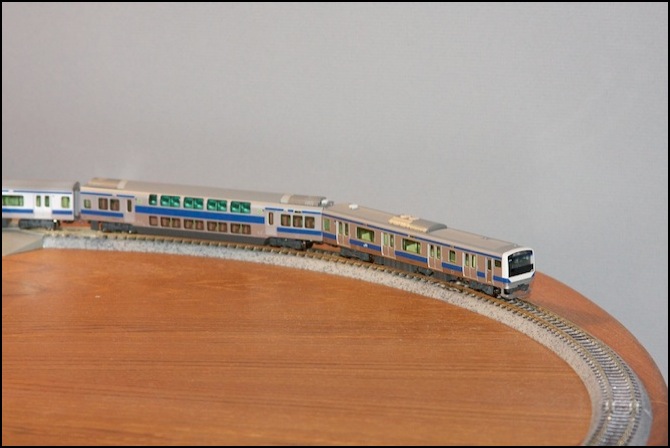
Kato 10-570, 10-571, 10-572, 10-283 (15 cars, 1 motorized)
DCC Status: not yet converted
Interior Lighting: compatible, not yet installed




